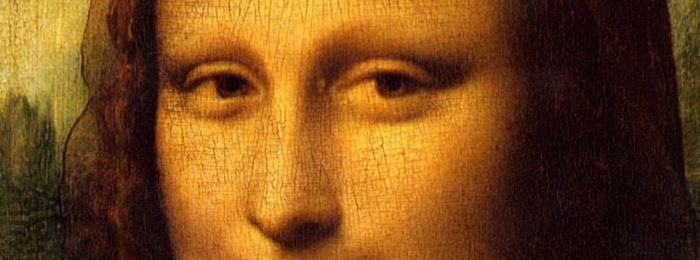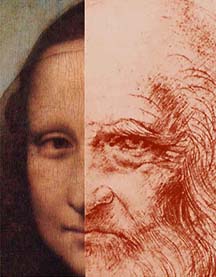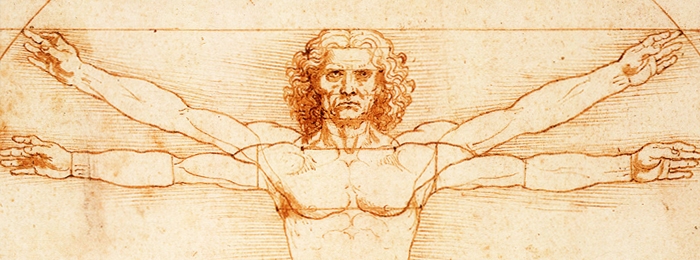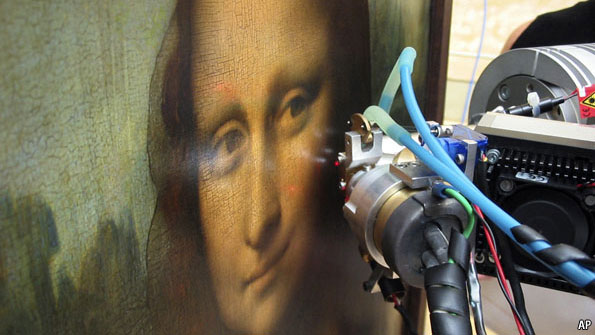Leonardo’s Vitruvian Man Helps Decode the Mona Lisa

Vitruvian Man Helps Decode the Mona Lisa
The Yin and Yang qualities of the two cojoined forms of the Vitruvian Man and those of the Mona Lisa (both considered to be self portraits of Leonardo Da Vinci)help us to experience our own wholeness. This leads to greater peace and happiness. These Yin and Yang qualities are also found in the Star of David and Christian Cross.
Leonardo said it best: “The outstretched arms and legs of a man form a square and a circle: the square symbolizes the solid physical world and the circle the spiritual and eternal. Man bridges the gap between these two worlds.”
-Leonardo Da Vinci, “The Magical Proportions of Man”
Leonardo Da Vinci’s Vitruvian Man (the Da Vinci Man with four arms and four legs in a square and circle) is the most popular secular symbol in the world. My ten years of research suggests that the Vitruvian Man is a universal symbol for greater love, relationships, success, health and the new age 21st century paradigm of indivisible wholeness, the paradigm for world peace. A New Renaissance!
The Da Vinci Man is a universal translator between scientific models (represented by the Da Vinci Man in the square) and religious symbols (represented by the Da Vinci Man in the circle). It is, therefore, a bridge between science and religion. There are amazing similarities between the sacred geometry of the Da Vinci Man, Yin-Yang, Star of David, Tree of Life, Christian Cross, Angels and Kabbalah.
The two cojoined Da Vinci forms in the square and circle are considered complementary opposites, like Yin and Yang. The Mona Lisa is the most famous painting in the world. Leonardo Da Vinci painted the Mona Lisa between 1503 and 1507, which makes the year 2006 the 500th anniversary of the Mona Lisa.
The Mona Lisa, like the Da Vinci Man, is considered by many to be the embodiment of a Western Yin Yang. (One side is darker than the other and looks more masculine. Mona Lisa’s famous smile is only on one side of the illustration.) Michael Gelb, author of “How to Think Like Leonardo Da Vinci” refers to the Mona Lisa as a Western Yin Yang.
What makes the Mona Lisa so famous? There are no visible brush strokes on the Mona Lisa, even under x-ray. This is similar to Leonardo’s first known painting of the Angel in his teacher Verrocchio’s “Baptism of Christ.” This is very unique. A person truly inspired by the angels could paint in such a manner. The play of light merges into the darkness (sfumato) in such a subtle way, it is very difficult to see where the borders of light and darkness begin and end.
Modern scholars (such as Jacques Franck) believe Leonardo used an extraordinary technique of microscopic brush strokes, layered as much as 30 times upon each other to achieve this effect. This is why the oil painting took years to finish.
Leonardo, Michelangelo and Raphael are considered the most famous of all High Renaissance artists. Raphael was so influenced by the Mona Lisa that it changed his artistic style. Francis I, Leonardo’s patron, wanted to purchase the painting from Leonardo on more than one occasion. He finally purchased it from Francesco Melzi, whom Leonardo bequeathed the painting to.
Napolean thought the Mona Lisa was the most magnificent painting he could place in his own bedroom. Romanticists of the 1870’s pictured the Mona Lisa as the ideal woman, and her smile was the classic enigma of a woman’s beguiling power.
Mona Lisa was stolen from the Louvre in 1911 and returned two years later. This only added to her popularity. Polls indicate that 80% of the people who come to the Louvre do so to see Mona Lisa. Illustrations of Mona Lisa have sold far more products than any other famous painting.
Mona Lisa’s hands look a little swollen, and some physicians say this is an indication she was pregnant. Giorgio Vasari says that the Mona Lisa is the wife of Francesca del Giocondo. Others speculate she is Isabella d’Este, the Duchess of Mantua, who often requested that Leonardo paint a portrait of her.
Others believe that the Mona Lisa is a painting of Leonardo’s mother, Catharina. This may explain why Leonardo kept the painting with him the rest of his life. It was in his room when he passed away, cradled in the arms of the King of France, some say.
Some believe that Mona Lisa was Leonardo’s alter ego. A comparison done by one art authority believes that it was Leonardo’s self-portrait. A comparison of Leonardo’s portrait with the Virtruvian man also indicates a self-portrait. Thus, Leonardo’s two most famous illustrations may be self-portraits.

If Leonardo’s face is placed over that of the Mona Lisa, the features are scientifically very similar. The Da Vinci Man (or person) may also be a code to understanding the Mona Lisa and the Last Supper by simply suggesting the embrace of our feminine and masculine natures (anima and animus). Men become kinder and more flexible; women become clearer and more purposeful. This happens naturally as we mature. Grandmas become stronger; Grandpas become softer. We all become more integrated. This leads to inner peace, peace on earth and good will towards all.
Dr. Lillian Schwartz of Bell Laboratories, author of “The Computer Artists Handbook,” believes that the Mona Lisa was a self-portrait of Leonardo Da Vinci. She used sophisticated computer modeling with precision measurements of scale and alignment. Dr. Schwartz compared the Mona Lisa with a self-portrait drawn in red chalk in 1518. When she placed the image of Leonardo over that of the Mona Lisa, the images were strikingly similar. The relative locations of the nose, mouth, chin, eyes and forehead in one precisely matched the other. Just flipping up the corner of the mouth would produce the mysterious smile. Author Michael Gelb believes that the Mona Lisa was an illustration of Leonardo’s soul portrait.
- Receive 4 new videos monthly (12 in total)
- Incredible discount – $3,287
- Bonuses – Fine Art eBooks and Videos
- Personal coaching by Web Art Academy Tutors
- Web Art Academy Diploma of Excellence
- Full membership after the 3rd month
- Instant access to all Video Lessons and Bonuses
- Incredible discount – $3,321
- Bonuses – Fine Art eBooks and Videos
- Personal coaching by Web Art Academy Tutors
- Web Art Academy Diploma of Excellence
- Full membership from day one
![]() To Your Creative Success,
To Your Creative Success,
Natalie Richy and Vladimir London
Web Art Academy Founders




This Post Has 0 Comments